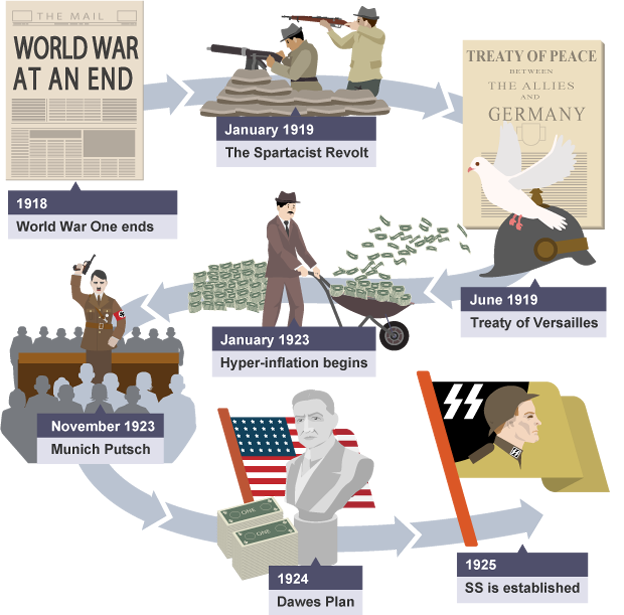Weimar Republic
How the Weimar Republic came to exist:
- The Kaiser has abdicated and left Germany
- A power vacuum has been created as there is no established form of government
- Millions of German workers have been killed or seriously injured during the war
- Germany has become an international pariah (outcast)
- Germany is subject to an imposed peace settlement
- In reality, this meant:
- Political instability - There were uprisings against the fledging republic even before it was properly formed.
- Economic ruin - The war has devastated the economy and further problems occur as a result of the Peace settlement.
- Unemployment - Millions of soldiers have returned home to find no jobs available.
The Republic
As the First World War drew to a close, morale in the army and at home collapsed. A series of defeats led to strikes throughout Germany. The Sailors at the Kiel naval base mutinied rather than sail to for a final showdown with the British fleet. Soldiers, sailors and workers formed councils or soviets with echoes of events in Communist Russia.
The Kaiser, William II abdicated and went into exile in Holland. A republic was proclaimed with the SPD leader Frederich Ebert as Chancellor (Prime Minster). The first act of the new government was to sign the armistice with the Allies. Many including Adolf Hitler saw this as an act of treason and the men who agreed to surrender became known as the “November Criminals.”
The new republic faced a host of problems. These included:
- Over two and half million Germans had died in the war and four million were wounded.
- The army and many other Nationalist groups in German society were unhappy that the Kaiser had been forced to abdicate. Some of these owed a very shaky allegiance to the new republic. Many were completely hostile and viewed the government with contempt.
- Economic problems were serious, including rising prices, unemployment and a continued Allied blockade.
- Germany faced the prospect of a harsh treaty that was being negotiated in Paris.
The Spartacist Revolt
Even before the constitution had been drawn up there was a serious challenge from the left. Many hoped to see a Russian style revolution in Germany. The left wing Spartacus movement led by Karl Liebknecht and Rosa Luxemburg began a revolt in Berlin in January 1919. They seized building throughout the city. The government fled the city.
Many feared the “red plague” and the defence minister Gustav Noske used the army and the Freikorps to crush the revolt. The Freikorps was a volunteer militia made up of ex army men set up to defend the borders of Germany. It was strongly anti-communist and took brutal steps to restore order with summary executions becoming common place. Liebknecht and Luxemburg were shot and the revolt was crushed. In Bavaria another Communist revolt was defeated with Freikorps help in May. Political violence had marred the foundation of the new state.
The video below provides an overivew to the Spartacist Revolt.
The New Constitution
Despite the Spartacus revolt, the majority of Germans voted for parties in January 1919 that favoured the new democratic republic. These parties were the SPD, the liberal DDP and the Catholic Centre party. The constituent assembly met at Weimar in February 1919 and Ebert was chosen as president.
The new constitution was very democratic. Germany was to be a Federal state with the states or Lander retaining considerable control over their own affairs. The parliament (Reichstag) was to be elected every four years with a system of proportional representation that meant it was impossible for one party to get an overall majority.
All people over the age of twenty could vote. The Reichstag dealt with issues such as tax, trade, defence and foreign affairs. As there were a large number of political parties, there were many coalition governments. During the fourteen years of the Weimar Republic, there were twenty separate coalitions. The longest government lasted two years. This political chaos caused many to lose faith in the new democratic system.
The head of state was to be the president who was elected every seven years. The president was the commander of the armed forces and was designed to a largely figurehead position. He did have the power to dissolve the Reichstag and to nominate the Chancellor who was to enjoy the support of the Reichstag. Crucially under Article 48, the president could declare a state of emergency and rule by decree. He could also veto laws passed by the Reichstag that he did not like.
The video below explains the Weimar constitution.
Summary of the key events in Weimar Germany:

